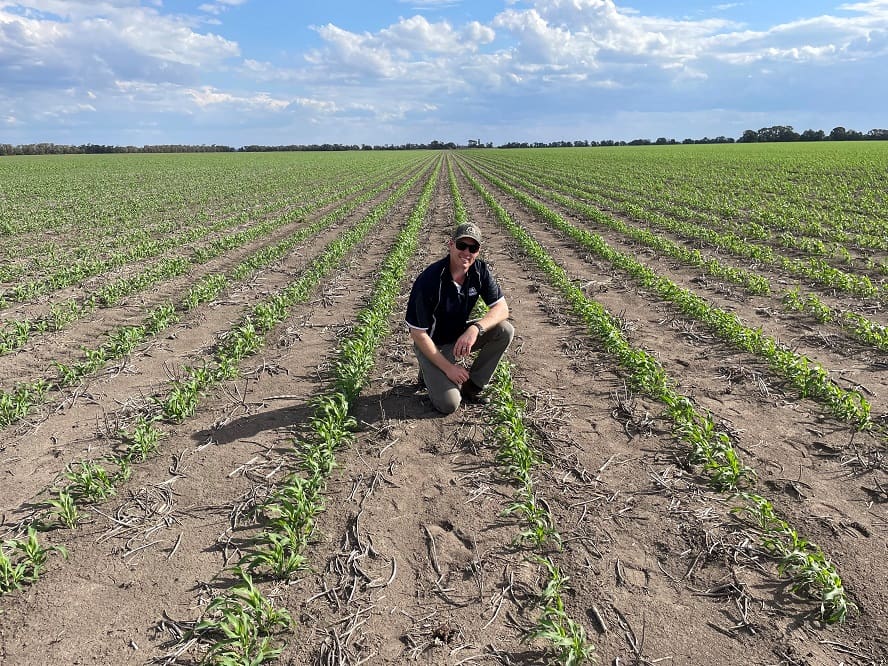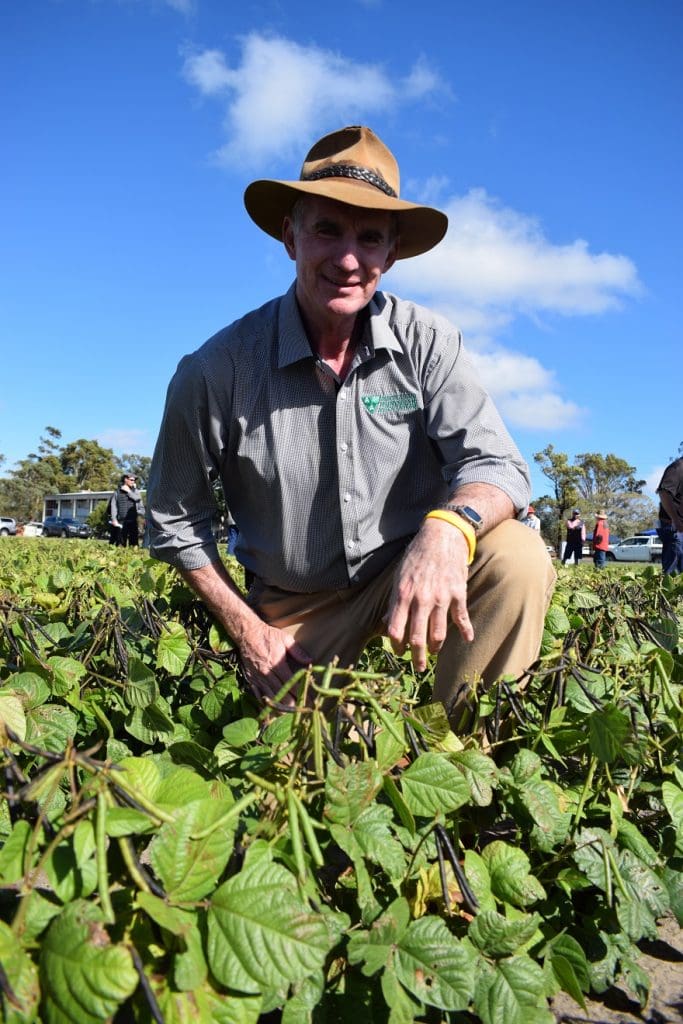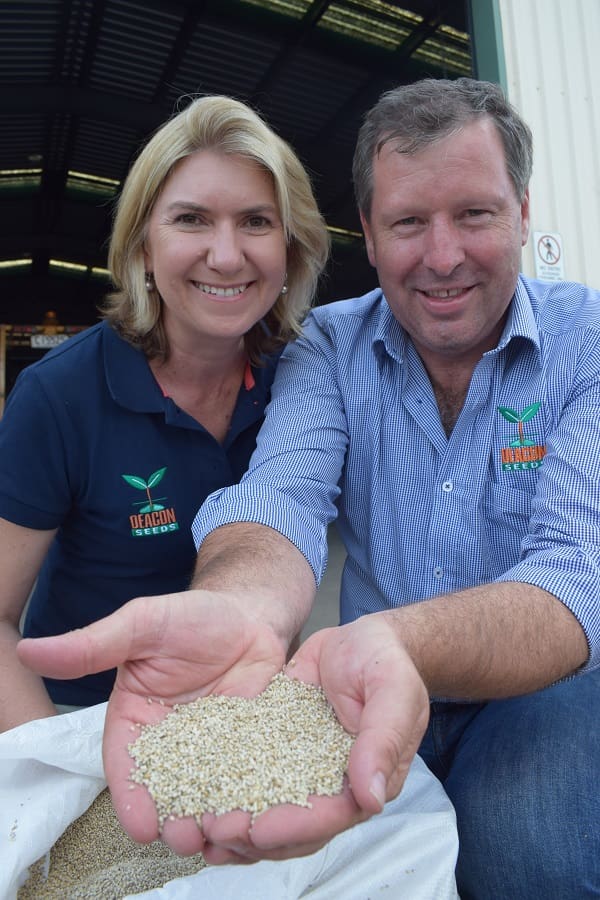
Pioneer Seeds territory sales manager for Dalby and Western Downs, Chris Rutland, in an early-planted crop of A66 sorghum at Brigalow on the Darling Downs this week.
HIGH subsoil moisture levels and rising soil temperatures have set the scene for a big summer crop planting throughout the northern farming zone this season.
While moisture levels are tight in Central Queensland, conditions are near ideal throughout the rest of the summer cropping region from the Darling Downs through north west New South Wales, the Liverpool Plains and into central NSW.
The first of the early crops of sorghum and maize have gone in, kicking off a summer cropping program that is likely to see substantial areas of those two crops combine with an increased area of cotton.
Sunflowers are also likely to make a resurgence, along with substantial plantings of mung beans and millets.
Maize
Pioneer Seed regional sales manager – northern, Adam Pitman, said corn sowing started in Queensland at the beginning of August, and was continuing strongly with dryland and irrigated corn plantings in southern and western Queensland, and through the north west plains of NSW and Namoi Valley.
“On the north west plains of NSW and the Namoi Valley we estimate that the majority of the early corn that will be sown has been, particularly around the Narrabri, Wee Waa and Moree areas where irrigation is available,” he said.
“Growers are sowing a combination of feed and grit corn, including longer season hybrids such as P1467, P2307, P1756 and a new hybrid P1837, at this time.”
Sorghum
Mr Pitman said the grain sorghum crop was about three weeks in, with crops establishing well and with good early colour.
“Grain sorghum remains a strong component of summer cropping programs. Some growers are giving increased consideration to cotton this season, but we are still seeing many dryland growers stick with grain sorghum due to its risk profile and greater opportunity to land on a good gross margin at the end of the season,” he said.
“Throughout southern Queensland and north west plains and Namoi Valley of NSW, A75 is going in on irrigation or a full profile of moisture on dryland ground, as growers hunt the higher yields. Other growers have opted to plant A66 as it is known for its adaptability to be a good allrounder.
“Those who are yet to plant the remainder, or all, of their summer cropping area are waiting for the next rain break to kick the planter into action, though.”
Cotton
Buoyant cotton prices and high water levels in the major storage dams throughout the eastern cotton-growing valleys have set the scene for increased cotton plantings this season.
Growers have had the opportunity to lock in prices of anywhere between $600/bale and $625/bale.
Cotton Australia is anticipating around 450,000 hectares will be planted this season, made up of about 370,000 irrigated hectares and 80,000 dryland hectares.
That gives the potential for a 4.5 to 5.0-million-bale crop, well above the 600,000 bales of two years ago and the 2.8 million bales in the season just gone.
Sunflowers
Pulse Australia and WeedSmart agronomist, Paul McIntosh, said sunflowers were going to be a significant part of the summer crop plant this year.
“There have been a couple of big years of winter crop in NSW with a lot of wheat and barley stubble on the ground and they need to rotate out of the cereal crops into summer crops to get past diseases, weeds and the ‘green bridge’,” he said.
“That’s why sunflowers are going to be a positive because you can plant them in the cooler conditions, it allows you to use herbicides with different modes of action that can get on top of the weeds and they are a very tall, quick-growing crop.
“Agronomically they are a relatively easy crop to grow. They are not as quick as mungbeans but quicker than sorghum. They have a taproot system and an ability to get up out of the ground when it is cool. It is an interesting crop to start planting right now in a lot of the wetter areas.”
Deacon Seeds general manager, Mark Schmidt, said there had been reduced sunflower plantings in recent years because of dry conditions, forcing processors to import stocks.
“But the good news this year is that with high freight rates overseas and increased consumption locally, there is an opportunity for growers to grow sunflowers even for the export market,” he said.
“We are close to Asia. If our prices are competitive in the world market we might be able to have the opportunity to export sunflowers this year.
“Prices over the last 12 months have been $900 to $1200/tonne for the greys and the blacks. The grey-stripe sunflowers are for the bird food market and the black sunflowers are for the oilseed, bird food and crushing market.”
Mr Schmidt said there were limited tonnages used in the crushing market in Australia, so the main use was for the bird food and stock feed markets.
“So, it is really important for any sunflower growers to talk to their preferred marketer to find out what quality they require and what the market size is. The last thing we want is for everyone to go out and plant any summer crop and have an oversupply,” he said.
“It is really important for first-time growers to check with their marketer on what prices are available for the coming season. I’d expect the prices to be lower this year because we will see a bigger crop.
“The main thing with growing sunflowers is to end up with a good, heavy seed size because a lot of it goes into the packaging market. Light sunflowers are hard to sell. Growing a good quality crop is the important thing, so make sure you plant on good moisture to give you a good chance of getting a larger seed size.”
Mungbeans
Mr McIntosh said mungbeans would be “on the radar” again for growers this summer after about 130,000 hectares went in last season.

Paul McIntosh
He said Central Queensland would need a lot of rain before they planted, but moisture levels throughout southern Queensland and NSW were looking promising for a substantial area of mungbeans to be sown over summer.
“Mungbeans really suit the farming system. They are a great short, rotation crop. It is very easy to go back to a winter cereal crop after a mungbean crop,” he said.
“They are chilling-sensitive plants. They don’t like cool soil or cool air temperatures. Soil and air temperature needs to be over 20 degrees Centigrade and rising.
“That chilling-sensitivity holds back their suitability for an early plant when soil temperatures are down around 10 to 15 degrees. So best to avoid planting early mungbeans.”
Mr Schmidt said the 2019-2020 mungbean crop was around 40,000 to 50,000 tonnes of high quality beans that went into processing through to Number 1 grade.
But in the season just gone, dry conditions in March in the lead into harvest caused significant downgrades.
“About 90 per cent fell into the manufacturing category with few going to the better-quality grade. So, buyers were disappointed that they had premium quality the year before and poor quality this year,” he said.
“But, all the beans have moved. Everything has been sold. So, the pipeline is dry again which is great news. You hate going into a new season with carryover crop.”
Mr Schmidt said mungbean prices for the past 10 years had been very strong, holding over $1000/tonne.
“It is too early to forecast what the mungbean prices will be for this year. But, going on the past few years, the average price has been in the $1100 to $1200/t range,” he said.
“Most of our beans this year went into China and Vietnam. Now we are starting to see interest from India coming into the market. The good news is that if countries like India come into the market they will consume big quantities which take stock out of the system. That can lead to higher prices.”
Millets
Mr Schmidt said a lot of regular millet growers were likely to plant the crop again, taking advantage of its agronomic benefits of being a very quick crop that provided stubble cover and could be used for grain, grazing and hay.

Deacon Seeds part owner, Karen Schmidt, and general manager, Mark Schmidt, say millet is likely to again form part of the summer cropping mix for some farmers this season.
“From a marketing perspective, the last couple of years have been drought years, so three years ago we were importing millets. This year we had enough millet grown locally,” he said.
“Millets are a supply and demand crop. They can be oversupplied. If you get an oversupply you need to go into the export market.
“The good news is that in the last two years we have been able to export millet into different parts of the world.”
Mr Schmidt said the world’s main supplier of millet was the United States which had suffered reduced production over the past two seasons due to drought.
“So, we will see more demand for Australia’s millet crop because the US have expensive freight rates and very long shipping time, whereas Australia is close to our export markets. We should be able to be competitive with the US on exports,” he said.
“If we have a reasonable crop and there is more than what the domestic market can handle I’m sure there will be an export market for millet this year.
“At the present time, stocks of most of the millets have run down. There is nothing left in the pipeline so there should be good demand for early crop.”
Mr Schmidt said White French was the variety most people grew because it was consumed widely and was the most exportable out of all the millets, but Japanese and Shirohie millets presented a great opportunity for niche markets. Red panicum was also a niche market crop.
Grain Central: Get our free cropping news straight to your inbox – Click here

HAVE YOUR SAY